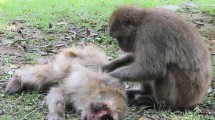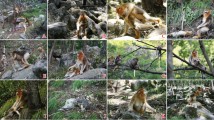Abstract
Researchers have long known that social isolation of some primates, particularly in infancy, can lead to the development of abnormal behaviors including self-injurious behavior (SIB). However, SIB can also occur in non-isolate-reared primates and can be triggered by frustration or environmental events. The subjects of reports of SIB have mostly been laboratory primates, usually macaques. Researchers had not systematically studied whether SIB occurs in zoo primates, and if so to what extent. Here we report the results of a questionnaire-based survey of British and Irish zoos on the extent of SIB in zoo primates, and whether it was associated with any environmental or developmental events. Responses indicated that though SIB occurred across a range of primate species, its incidence was very low. Respondents identified a variety of environmental events as implicated in initiating SIB, and though the data set is too small to confirm them statistically, several trends were discernible. We conclude that SIB is not a major problem in zoo primates.
Similar content being viewed by others
References
Allyn, G., Deyme, A., & Bègue, I. (1976). Self-fighting syndrome in macaques: 1. A representative case study. Primates, 17, 1–22.
Anderson, J. R., & Chamove, A. S. (1981). Self-aggressive behaviour in monkeys. Current Psychological Reviews, 1, 139–158.
Bernstein, I. S., Schusterman, R. J., & Sharpe, L. G. (1963). A comparison of rhesus monkey and gibbon responses to unfamiliar situations. Journal of Comparative and Physiological Psychology, 56, 914–916.
Bollen, K. S., & Novak, M. A. (2000). A survey of abnormal behavior in captive zoo primates. American Journal of Primatology, 51(Suppl. 1), 47 (abstract).
Chamove, A. S., & Anderson, J. R. (1981). Self-aggression, stereotypy and self-injurious behaviour in man and monkeys. Current Psychological Reviews, 1, 245–256.
Cross, H. A., & Harlow, H. F. (1965). Prolonged and progressive effects of partial isolation on the behaviour of macaque monkeys. Journal of Experimental Research in Personality, 1, 39–49.
Eaton, G. G., Worlein, J. M., Kelley, S. T., Vijayaraghavan, S., Hess, D. L., Axthelm, M. K., et al. (1999). Self-injurious behaviour is decreased by cyproterone acetate in adult male rhesus (Macaca mulatta). Hormones & Behavior, 35, 195–203.
Erwin, J., & Deni, R. (1979). Strangers in a strange land: Abnormal behaviors or abnormal environments? In J. Erwin, T. L. Maple, & G. Mitchell (Eds.), Captivity and behavior (pp. 1–28). New York: Van Nostrand Reinhold.
Gluck, J. P., & Sackett, G. P. (1974). Frustration and self aggression in social isolate rhesus monkeys. Journal of Abnormal Psychology, 83, 331–334.
Grewal, B. S. (1981). Self-wrist biting in Arashiyama-B troop of Japanese monkeys (Macaca fuscata fuscata). Primates, 22, 277–280.
Harlow, H. F., & Harlow, M. K. (1962). Social deprivation in monkeys. Scientific American, 207, 136–146.
Jones, I. H., & Barraclough, B. M. (1978). Auto-mutilation in animals and its relevance to self-injury in man. Acta Psychiatrica Scandinavica, 58, 40–47.
Kraemer, G. W., & Clarke, A. S. (1990). The behavioural neurobiology of self-injurious behaviour in rhesus monkeys. Progress in Neuro-Psychopharmacology & Biological Psychiatry, 14, S141–S168.
Lutz, C., Marinus, L., Chase, W., Meyer, J., & Novak, M. (2003b). Self-injurious behavior in male rhesus macaques does not reflect externally directed aggression. Physiology & Behavior, 78, 33–39.
Lutz, C., Well, A., and Novak, M. (2003a). Stereotypic and self-injurious behavior in rhesus macaques: A survey and retrospective analysis of environment and early experience. American Journal of Primatology, 60, 1–15.
Meyer-Holzapfel, M. (1968). Abnormal behaviour in zoo animals. In Fox, M. W. (ed.), Abnormal Behavior in Animals. W. B. Saunders, Philadelphia, pp. 476–503.
Mitchell, G., Soteriou, S., Kenney, L., Towers, S., Schumer, C., Dillin, L., et al. (1988). Golden-bellied mangabeys (Cercocebus galeritus chrysogaster) at the Sacramento Zoo: adult heterosexual pairs. Zoo Biology, 7, 1–13.
Mootnick, A. R., & Nadler, R. D. (1997). Sexual behaviour of maternally separated gibbons (Hylobates). Developmental Psychobiology, 31, 149–161.
Morris, D. (1964). The response of animals to a restricted environment. Symposia of the Zoological Society of London, 13, 99–118.
Novak, M. (2003). Self-injurious behavior in rhesus monkeys: new insights into its etiology, physiology and treatment. American Journal of Primatology, 59, 3–19.
Skyner, L. J., Amory, J. R., & Hosey, G. (2004). The effect of visitors on the self-injurious behaviour of a male pileated gibbon (Hylobates pileatus). Der Zoologische Garten, 74, 38–41.
Tiefenbacher, S., Novak, M. A., Jorgensen, M. J., & Meyer, J. S. (2000). Physiological correlates of self-injurious behavior in captive, socially-reared rhesus monkeys. Psychoneuroendocrinology, 25, 799–817.
Tinklepaugh, O. L. (1928). The self-mutilation of a male Macacus rhesus monkey. Journal of Mammalogy, 9, 293–300.
Weld, K. P., Mench, J. A., Woodward, R. A., Bolesta, M. S., Suomi, S. J., & Higley, J. D. (1998). Effect of tryptophan treatment on self-biting and central nervous system serotonin metabolism in rhesus monkeys (Macaca mulatta). Neuropsychopharmacology, 19, 314–321.
Acknowledgments
We thank all the zoos that responded to our survey. We thank the Federation of Zoological Gardens of Great Britain and Ireland (FZG) Research Group, particularly Amy Plowman and Stephanie Wehnelt, for supporting the research and helping to ensure its success.
Author information
Authors and Affiliations
Corresponding author
Rights and permissions
About this article
Cite this article
Hosey, G.R., Skyner, L.J. Self-injurious Behavior in Zoo Primates. Int J Primatol 28, 1431–1437 (2007). https://doi.org/10.1007/s10764-007-9203-z
Received:
Accepted:
Published:
Issue Date:
DOI: https://doi.org/10.1007/s10764-007-9203-z




